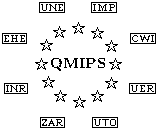 Deliverable D14
Deliverable D14
Approximation Techniques in Stochastic Petri Nets
The research in the computational aspects of performance evaluation using
Petri Net models goes in three directions: exact analysis, bounds and
approximations, simulations.
The first aspect is the topic of deliverable
D13 and of many papers
appearing in the Proceedings of the Workshop of Torino on Solution Methods
(CWI Tracts #105 and 106, O.J. Boxma and G.M. Koole (eds.), 1994).
The second aspect is the topic of D16a, which has already been delivered.
Both aspects are still the purpose of an intense ongoing research within
the project.
Approximation techniques are used when exact models are not mathematically
tractable, or, when they are, not solvable numerically due to the size of
the problem, inaccuracies of instabilities. One may distinguish three
different approaches for obtaining approximate results for quantitative
measures of stochastic Petri Nets, such as throughputs and average response
times.
- The decomposition/aggregation
- techniques, in which a complex system
is divided into smaller sub-systems which can be solved more easily. The
partial results are then collected to construct the global performance
measure. The exploitation of the structure of the system is crucial in order
to obtain good results. When analyzing Stochastic Petri Nets with
exponential firing times, this principle can be applied at two levels.
One idea is to try to aggregate the states of the Markov chain representing
the evolution of the net, using quasi-lumpability properties. This idea has
been applied in deliverable D12-3, where, in actually, performance bounds are obtained.
Another idea is to exploit the structure of the net to identify subnets
reducible to elementary components. It can be coupled with fixed point ideas
to obtain iterative approximation algorithms. This approach is used in
deliverables D14-1, D14-3 and D14-4.
- The task graph
- approach, which applies to the Petri Nets of the Event
Graph subclass. It consists in representing the evolution of the Petri Net
by a stochastic (PERT) graph, and apply approximation techniques for these
objects. A survey of such ideas is provided as deliverable D14-2. This
topic is also addressed in the invited paper of F. Hartleb: ``Stochastic
Graph Models for Performance Evaluation of Parallel Programs and the
Evaluation Tool PEPP'', which appears in D1 (the proceedings of the Erlangen
Workshop).
- The performance bounds
- approach, which consists in building
computable lower and upper bounds for the performance measures of interest.
The bounds themselves may already give a good approximation, and when they
do not, combining them in a simple way sometimes gives a much better
estimate. Once again, the structure of the net analyzed plays an important
role in the technique used for obtaining these bounds and their accuracy.
Bounds may be obtained using stochastic monotonicity and convexity ideas, or
using some conservation laws and a fine analysis of the dynamics of the
system, coupled with linear programming. Several papers using this sort of
approach successfully have been provided in deliverable D12 (Bounds for
Networks), and more are in preparation.
- D14-1
- Approximation Techniques for Stochastic
Macroplace/Macrotransition Nets, by H. Jungnitz, A. Desrochers and M. Silva.
In chapter 3 of the Proceedings of the Sophia-Antipolis Workshop
on Stochastic Petri Nets.
- D14-2
- A Survey on Solution Methods for Task Graph Models, by
F. Baccelli, A. Jean-Marie and Z. Liu.
In chapter 3 of the Proceedings of the Erlangen Workshop on
Formalisms (D 1).
- D14-3
- Approximate Throughput Computation of Stochastic Marked Graphs,
by J. Campos, J.M. Colom, H. Jungnitz, and M. Silva
(front page).
In the Proceedings of the Torino Workshop on Solution Methods. This
paper appears in the IEEE Transactions on Software Engineering,vol.
20, no. 7, pp. 526-535, July 1994.
- D14-4
- Approximate Performance Analysis on Petri Net Based Models
of Manufacturing Systems, by M. Tilgner and M. Silva
(front page).
This paper appears in Proceedings of the 1994 IEEE International
Conference on Robotics and Automation, San Diego, California, May 1994.
Page Web by
Alain Jean-Marie
(Alain.Jean-Marie@sophia.inria.fr)
Last Modified: 26 September 1995.
 Deliverable D14
Deliverable D14 Deliverable D14
Deliverable D14